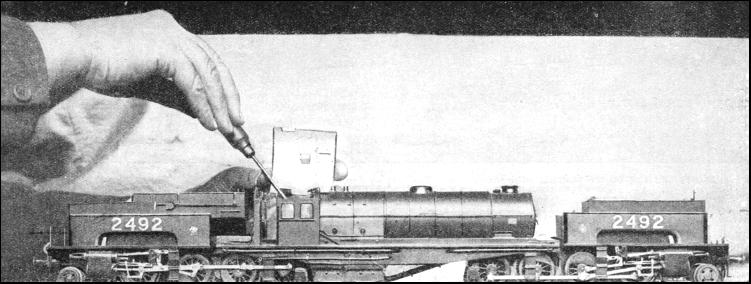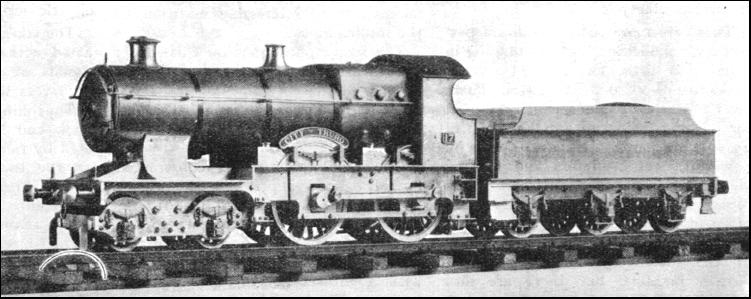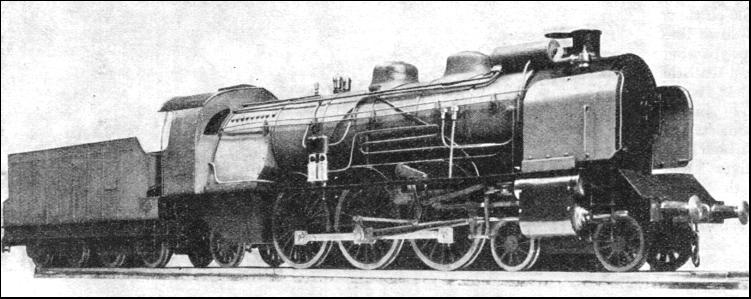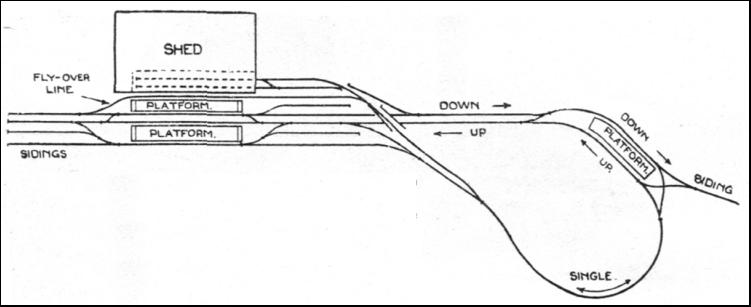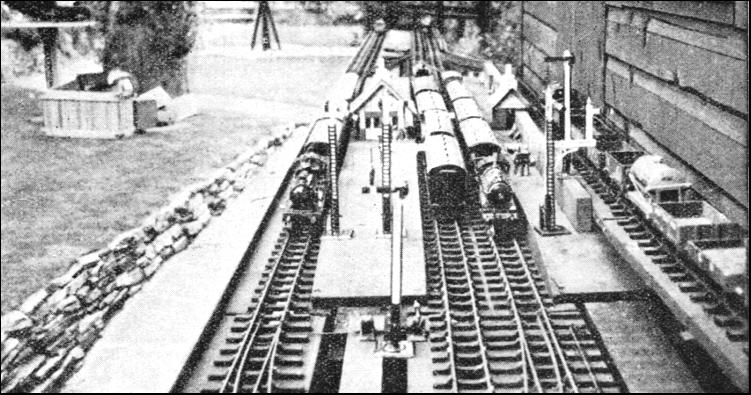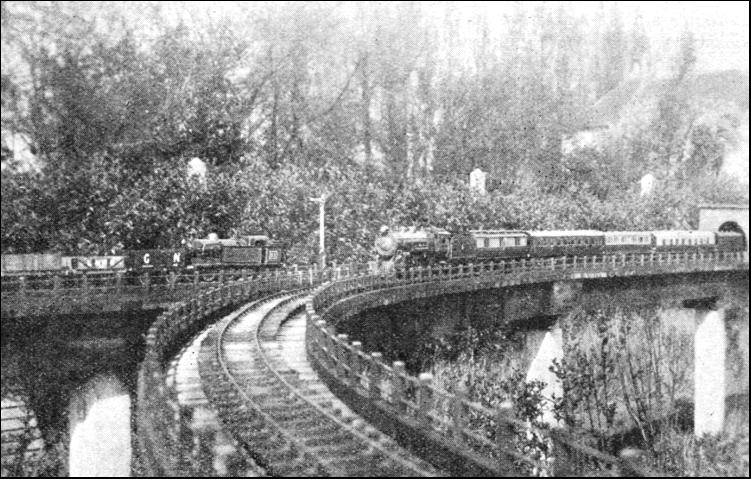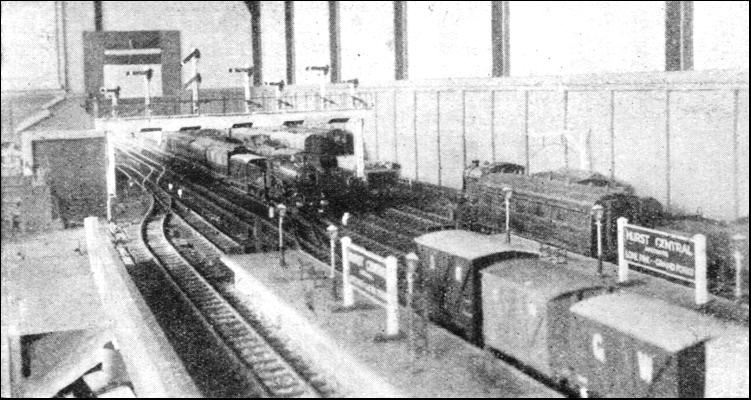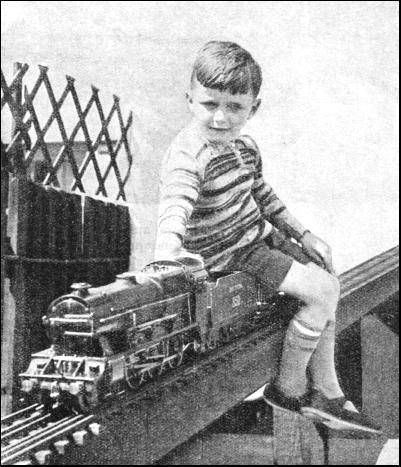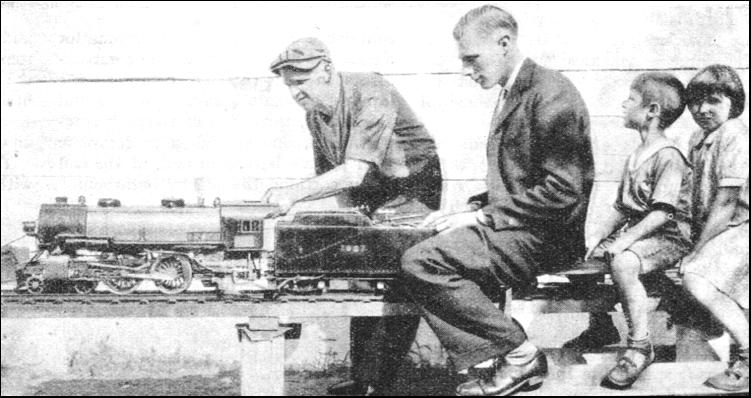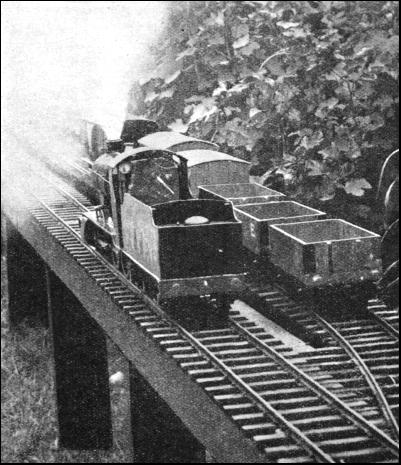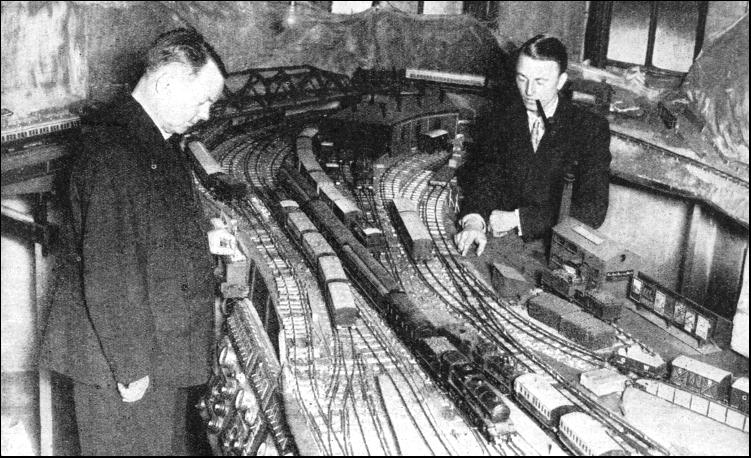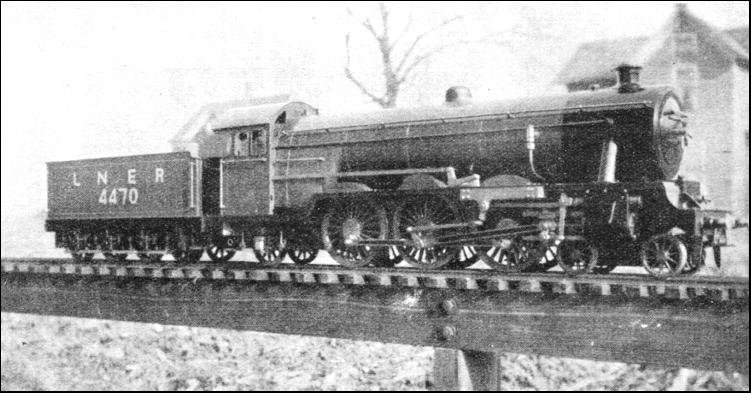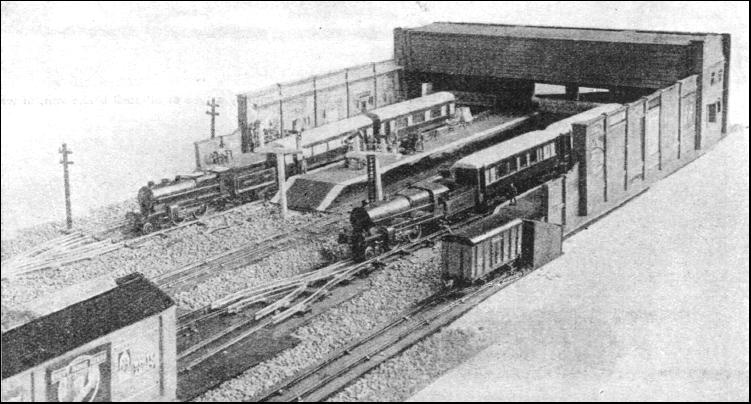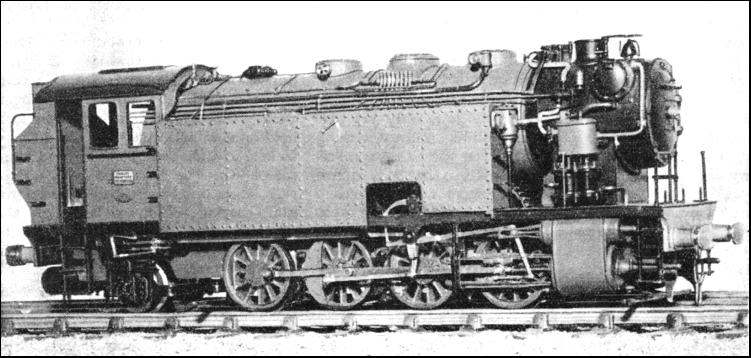|
|
ON the first page on model railways we described in detail a fine model railway built to a gauge of 5/8 in. The next largest "standard" gauge for model railways is Gauge 0, measuring 1-1/4 in. between the rails. Gauge 0 railways can be laid indoors or in the open air. One of the finest Gauge 0 railways in existence is that owned by Mr. G. P. Keen. Three rooms of a large house are used to accommodate the numerous tracks of this line, every detail of which is accurately modelled to correct scale. The whole railway is electrically operated from a direct current supply at 25 volts. There are three frames for working the signals and points ; the largest frame has ninety levers.
There are more than two dozen perfect scale model locomotives ranging in type from little four-coupled saddle-tanks to 2-8-0 + 0-8-2 Garratts. There are two Garratt engines, which are used for pushing trains up an incline of 1 in 25. These locomotives are driven by powerful electric motors and not by steam, but externally they are exact replicas of the prototypes. Every detail of the motion and valve gear is faithfully reproduced and works perfectly. Many of the locomotives follow standard British practice, but there are also several that closely resemble the most powerful tank and tender engines in use on the continent of Europe. A similar scheme of construction has been adopted for the rolling-stock. The coaches are complete in every detail and are of many different types. Particularly interesting vehicles on this railway are models of the mail vans used on the French P.L.M. Railway to carry the English mails for India from Calais to Marseilles. Another model represents an International Sleeping Car Company wagon as used on the "Golden Arrow" express to carry the boxes containing the registered baggage from Victoria Station, London, to Paris. A model of the Sleeping Car Company's all-steel brake van with bath compartment, as used on the Orient Express and other trains makes a very interesting addition to the rolling-stock.
The scores of wagons on this model railway are representative of every type in the service of the full-size lines. There are complete trains of coal trucks, timber wagons, ballast cars, and brake vans. One remarkable model constructed by Mr. Keen represents the North Eastern Railway set built in 1917 for the carriage of heavy guns up to 150 tons in weight. The prototype of this set comprises three 60-tons plate wagons with a total tare weight of 83 tons 13 cwt. The model is complete with gun-cradle and saddle, and is carried on 36 wheels, divided among six bogies. A Gauge 0 railway, constructed and operated on rather different lines from the foregoing, is owned by Mr. Erik L. Bown. This railway was built to stand the hard wear and tear of juvenile handling. All the locomotives and rolling-stock were purchased, but the track was made up from standard commercial parts. Electric power is taken from the 200 volts A C. mains supply, reduced and rectified through an transformer to 10-12 volts D.C. The up and down lines are wired independently to a two-way controller for regulating the speed of the trains and reversing their direction as required. The sidings are wired to control switches, so that they can be cut off from the electric supply if necessary. The stations and passenger trains are fitted with electric light. Points and signals are operated by rodding worked by levers in the various signal boxes.
The rolling-stock is fitted with a special hook and loop coupling device, operated by ramps placed at various points on the track, so that trains can be assembled or divided without touching by hand. The running rails are of rustless steel carried in chairs spiked to the sleepers. The centre live rail is of brass and supplies current to the locomotives through sliding contacts. Track is ballasted with fine slag chippings. The motors of all locomotives are fitted with permanent magnets which, by reversing the poles on the controller, allow of forward or reverse movement of the train. A pick-up apparatus for Post Office mails forms part of the track equipment, and a postal van attached to the trains enables mail bags to be picked up while travelling at speed. All locomotives, rolling-stock, bridges, tunnels, stations, and engine sheds are built to a scale of 7 mm. to the foot. Another very fine indoor railway, built to the 0 gauge, is that owned by the Rev. A. H. Webb. This line occupies a very considerable space in its owner's vicarage and represents many years' work by the Vicar and Mr. G. Rather, who has designed most of the lay-out and equipment. ' The railway has over 2,000 ft. of track, more than a hundred points, and is electrically operated throughout. Current obtained from the house mains is transformed down to a pressure of eight volts. To work the system at its full capacity it is necessary to have four people stationed at control switchboards placed alongside the track. The railway is raised to table height for convenience, and great care has been taken with the scenic effects, which include a large number of tunnels and bridges, sheds, and sidings.
There are seven stations, comprising nineteen platforms, complete with signals, bridges, and the usual equipment to be found on modern railway premises All repairs and track laying are carried out by Mr. Webb and Mr. Rather, and they have made a large number of the coaches and trucks. This railway, in common with most model systems run as a hobby, is constantly being added to, and considerable time is spent in effecting improvements to the various details. The electrically-driven engines (which have been purchased) pick up current from an outside third rail as used on the Southern Railway's electrified system. There are about twenty-four engines in use on the railway, and the rolling-stock comprises nearly 200 coaches and wagons. Of these, fifty-six are scale models of express passenger stock, twenty are suburban carriages, and the remainder various types of goods wagons. The railway is run, as far as possible, in accordance with "big practice," and there are the usual down and up roads with local and main lines.
A typical outdoor Gauge 0 railway is that of Mr. Cecil J. Allen, which is so planned that it can be used, when necessary, by large numbers of boys bringing their own locomotives. For this reason it is raised up on trestles at an average height of 3 ft. for convenience in operating. The trestle structure is of considerable strength, so that the owner shall not feel unduly nervous if he sees a number of spectators all leaning up against the track at once. The uprights are wrought iron angles of the kind commonly used in fencing, of 1-1/2 in. square section and 3/16 in. thick, driven well into the ground in pairs. Timber cross-pieces of 4 in. by 2 in. section, set up on edge, connect them at the top ; above these are laid horizontal bearers of 4 in. by 3/4 in. section, to which the main longitudinals are attached. The latter are for the most part of timber, 6 ft. long and of from 1-3/4 in. to 2 in. square section. A pair is used to each track, spaced 1-1/2 in. apart, with the sleepers bridging the gap, an arrangement allowing for rapid and efficient drainage. Three longitudinals are used to carry a double track. From the main station, with its three platforms, the double main line is carried for some 70 ft. down the side of the garden, after which it bends round at 45 degrees into a second station with an island platform. From there, the two lines now converging to single track, the line curves back through 135 degrees to the far side of the garden, along which it returns for some distance, finally recrossing the garden diagonally back towards the main station. A complete circuit of the garden, from the main station back into the same station again, gives a run of roughly 200 ft. This can be completed without difficulty by a locomotive with a good modern clockwork mechanism, hauling a train of reasonable size, on the scale model permanent way with which the whole of the track—now well over 400 ft., in total extent—has been laid. A special point has been made of spacing the sleepers only 1-1/2 in apart. Although involving the use of more sleepers and chairs, this adds considerably to the realistic appearance of the line.
Alongside the main station is a garden shed, and this has now been used for the provision of additional trackage under cover. Inside this there are two stations, one low level, at the same height as the main system, which is level throughout, and the other a high level station immediately above. The high level line emerges from the shed, and after a short straight run, swings over the main line by a skew girder bridge, of which the equivalent span in full size would be about 150 ft.; it then descends on a gradient of about 1 in 33, to join the line coming across from the far side of the garden. Outside the shed a connexion has been laid down from the high level, past the main station, to join the sidings at the inward end. This thus serves to provide a fly-over line, and is useful as a means of releasing the locomotives when all the platforms at the main station are occupied by incoming trains. Ample siding room is provided at either end of this station. The stock of model clockwork locomotives includes a "Flying Scotsman" type L.N.E.R. "Pacific," which in one of the illustrations can be seen running on to the main line after having come across the garden ; a "Royal Scot" of the L.M.S., which is the fastest and most powerful engine on the line, and has succeeded in hauling a train of fifteen bogie coaches without assistance ; a Midland compound 4-4-0 and a "George the Fifth" 4-4-0 of the L.M.S., and a "Shire" class 4-4-0 of the L.N.E.R. In addition there are free-lance 4-4-0 and 0-6-0 tender locomotives, a very powerful 0-6-0 tank, and an 0-4-0 locomotive. In addition to the foregoing locomotives there is also a 4-4-0 steam locomotive, but the use of externally-fired steam engines out-of-doors is necessarily limited to windless days. A variety of passenger coaches and freight stock is in use.
On "gala days," when as many as forty boys at one time have been "on the line," many of them with their own engines, not all the details of operation, we fear, would commend themselves to the Ministry of Transport. Racing of locomotives along the 70 ft. of double main line is always an exciting event, especially when the convergence to single line is reached on the opposite side of the garden ; beyond this point the engine first across sometimes suffers the indignity of being caught up and "bumped"—after the fashion of University boat-races—it the second engine happens to have the greater staying power. Speed tests also take place along a measured length of the straight ; and in these events the owner's "Royal Scot" has never yet had to acknowledge defeat. But at other and quieter times more scientific operation of the line is possible. The advantage of an outdoor line of this description is that, although the maximum of realism is not possible in the matter of track and station equipment, the railway is able to afford pleasure and healthy exercise to a considerable number of users at once, and also a course of no inconsiderable value for testing the speed and haulage capacity of locomotives on a well-laid track. We have referred to Gauge 1 railways on the other page, and although this popular size can be used for indoor railways in large houses, it has been adopted more widely for garden layouts. A fine example of a Gauge 1 garden railway is that owned by Mr. V. B. Harrison. Gauge 1 measures 1-3/4 in. between the rails. In the construction of this model railway an attempt has been made to reproduce the running conditions of a full-size line.
There are about 500 ft. of track laid on a foundation which is supported on concrete posts. A run of 400 ft. is covered by a train before it returns to the starting-point. This distance may be compared with the route mileage of a full-size railway. The line is laid with brass rails held with wooden keys in chair fastened to properly-proportioned sleepers. On one portion of the line the sleepers are nailed to longitudinal battens and on the other the sleepers are laid in ballast only. The lay-out, shown in the drawing below, consists of a central station which is housed in an asbestos building. There will be, eventually, three outdoor stations, as shown in the drawing. The making of additions, either to track or to equipment, constitutes one of the most fascinating aspects of model railway work. The trains can be made to take various routes as required, and will also, by means of spring-points, traverse the whole of the lines, finally returning to the starting point in the central station. The track is really a long single line, but is so arranged through the stations that the effect of an up-and-down line is obtained. Express trains passing through the stations give a most realistic effect, and films of the models shown on a cinema create the illusion of reality. The locomotive stud consists of eleven clockwork engines which are used by the junior "operatives" and twelve steam engines of both tender and tank varieties. Two are of the outside-fired "pot-boilered" type, three internally fired on the low-pressure system and three high-pressure-fired engines. The fuel used for each system is methylated spirit. Then there are three coal-fired engines, all of which are very interesting models. One is over twenty years old, and was the first engine of this size constructed by Mr. Harrison to burn coal ; it has worked successfully ever since. At one time it was the smallest engine in the world to burn coal. The second engine is a low-pressure coal-fired model with a satisfactory performance. The third is a model of the famous Great Western Railway engine, "City of Truro." This is a most successful engine, and it will run for over six minutes on about two teaspoonfuls of pea-size coal.
All, except two of the high-pressure engines, are fitted with axle-driven pumps which, when running, pump water from the tenders or side tanks into the boilers. This enables non-stop trains to be run, and two of the engines have on occasions covered a mile to a mile and a half in twenty to twenty-five minutes. The carriage stock consists of about eighty coaches and wagons of various types and sizes. The signalling arrangements are carried out to conform with correct railway practice, and consist of the old type semaphore, upper quadrant and modern colour-light signals. All the signals and points are worked in the central station from a properly constructed signal-box with interlocking gear. The signals, the platforms and the station yard are all lit electrically with miniature lamps. Many of the signals work automatically, by means of track circuits. A feature of model railway engineering that will appeal to many is economy in construction. Thousands of pounds are spent annually on model railways throughout the world, but expense does not bar the hobby to those unable to make heavy purchases of models or materials. Many excellent examples of model railway work are built almost entirely from waste material that would normally be thrown away as waste.
Some miniature railways have, in fact, been constructed in this manner to demonstrate the possibilities of real craftsmanship when applied to such work. A line of this description has been built by Sergeant W. H. Crothall, R.A.F., over a period of twenty years, during which time the railway has earned large sums for charity by exhibition at public functions. There is also a commercial use lor railway models. Many of the large companies use them for publicity purposes, or to assist intending passengers in the choice of their seating accommodation. Such models are usually built by firms who specialize in this work. A fine example of craftsmanship is the model of a luxurious tourist coach on the Great Indian Peninsula Railway, built by Messrs. Bassctt-Lowke, Ltd., for the Indian State Railways. The model measures 4 ft. 3 in. long by 7 in. wide and 6-1/2 in. high, and is built to a scale of 3/4 in. to the foot. The use of a private coach, or tourist car, as it is called in India, enables the traveller to be independent of hotels. He brings his own servants and makes his own catering arrangements throughout the journey, and the coach can be detached and left indefinitely at any place he desires to visit. This type of vehicle is becoming popular in India. The woodwork of the coach is of polished teak and oak. and the car contains a complete suite of rooms for passengers and servants. The compartments in the carriage comprise the kitchen, servants' quarters, dining and day saloon, three double sleeping compartments, one special suite complete with private bathroom and, at the end of the corridor, the general bathroom.
All these features are faithfully reproduced in the model, and even the smallest accessory is beautifully finished. The kitchen has a scale model stove and sink, and the dining-room has yellow silk curtains and blue pile carpet, polished table and six chairs of finest teak, and easy chairs and sofa upholstered in blue leather. Each sleeping compartment is equipped with a scale model writing-table, wardrobe, beds, and a special metal rack, and the bathrooms contain showers in addition to the usual bath, wash-basin and other fittings. Each compartment is lit by special white electric globes, and has an exhaust fan to keep the room cool. The exterior is finished in cream with gold lines, with a grey roof. The glass windows are protected by two shutters—a mosquito shutter and an ordinary wooden shutter. The model is cut away to show every detail. Models of railway prototypes are used extensively in the film industry. It is an expensive business to run a full-sized train over a smashed bridge into a ravine. A model can portray this part of a film just as well—and clever photography does the rest. The models must, however, be perfect in every detail, as the camera picks out any fault in design and workmanship and magnifies it. A good photograph is, in fact, a recognized test for perfect modelling. Models have played an important part in many famous films with a railway interest. For the filming of "Rome Express" a magnificent model of a P.L.M. Pacific locomotive was built by Messrs. Bond's of Euston Road, Ltd., to a scale of 1 in. to the foot. Railway models of all kinds may be seen at the Science Museum, South Kensington, and other educational centres. Demonstration models of locomotives, trains and railway equipment are in constant use by railway companies for instructional purposes, and are employed by other bodies for publicity.
A particularly interesting model for public demonstration was built by Bassett-Lowke, Ltd., for the General Post Office. This model comprised a perfect working replica of an L.M.S. mail train. The track was built to the 1-3/4 in. gauge, and is 120 ft. long, with loops at either end for continuous running. The centre of the track is occupied by a station of modern design with the usual equipment, booking offices, waiting rooms, station-master's offices, bookstalls, notice-boards, and all those accessories that contribute to a realistic appearance. At two positions along the track scale-model wayside pick-up and delivery apparatus is fitted, which enables the model mail bags to be delivered and collected while the train is travelling at full speed. This operation has been reproduced in miniature down to the ringing of the bell automatically, as is the practice on the prototype. Two locomotives (one as a reserve) are used, the L.M.S. "Royal Scot" and "Black. Watch." Every external detail on the locomotives and coaches is faithfully reproduced to scale, and the whole train is operated electrically by means of a third conductor rail on a pressure of 20 volts. The model is controlled and operated from a signal box near the station, where the switches and resistance are housed. The signals are of standard upper-quadrant pattern.
One of the most fascinating branches of miniature railway work is the building and driving of small coal-fired locomotives for passenger hauling. Railways worked by these engines must not be confused with miniature public lines. Miniature garden railways are laid from 1-3/4 in. up to about 5 in. gauge, and their length is governed by the space available. The track is usually straight and raised on wooden trestles, the height above ground level varying with the contour of the garden. Trains are made up of flat cars with four-wheeled bogies at either end, the axles running in ball bearings. The height of the cars above the ground enables passengers to ride on them "side-saddle" with the feet clear of the ground, or "astride" with the aid of "stirrup-irons" attached to the cars. Speeds up to fifteen miles an hour can be attained in safety by this means and the use of ball-bearing eight-wheeled cars enables the engines to haul heavy loads with ease. The building of a passenger-carrying garden railway may be carried out in a number of ways, depending on the skill, financial resources, and the time at the disposal of the builder. The wooden trestle method is probably that most commonly used. A series of holes, about 2 ft. deep and 4 ft. or so apart, is dug in the ground, preferably alongside a garden path. Timber posts about 6 in. or 4 in. wide by 2 in. thick and 3 to 4 ft. high, according to the configuration of the ground, are placed in the prepared holes and carefully alined. The posts must be upright and their tops all at the same level. The post tops are shouldered to take longitudinal battens of 3 in. by 1 in. or 4 in. by 2 in. timber, which are bolted in position to form a continuous wooden foundation for the sleepers. These are of wood, usually 1 in. by 5/8 in. section, and 4 to 6 in. long, nailed to the foundation battens at regular intervals. The track is usually of extruded brass of the same section as flat-bottomed rails—a favourite and inexpensive material, as it does not deteriorate through exposure to the weather. It is spiked down to the sleepers. The spikes are made from square-topped electrician's staples, cut in halves. Alternatively, screws may be used to secure the rails to the sleepers.
This kind of railway is simple and cheap to build, but other methods of construction may be used, such as, for example, concrete arches placed end to end so as to form a viaduct. The arches are "cast" in place in wooden box moulds. Sleepers and rails are laid on top of the arches as in real practice. A low brick wall, or sharply cut embankment, also makes a good foundation for a passenger-carrying line. The cars for these miniature railways may be made of wood with cast-iron wheels and steel axles running in ball bearings. Simple brakes, with shoes acting on the wheel tyres, or bands on drums on the axle, are fitted to all types of cars, and are essential, since it is impracticable to use brakes on the locomotives. The building of the engines is rather too involved a process to describe in detail here. Such construction, however, follows "big" practice. In general design a miniature locomotive resembles that of a full-size machine. Details arc, of course, simplified, but the framing, cylinders, wheels, and fittings may be regarded as the "real thing" in miniature. This is especially true of the boiler, which is provided with a water-surrounded firebox, carefully stayed, and a number of fire- and superheater tubes. The best fuel for use in such engines is Welsh steam coal. The amount of heat given out by a few cubic inches of this coal is remarkable. Boiler pressures range from 75 to 150 lb. per square inch, and are easily maintained by the action of the blast, which, under heavy pulling. will often draw up the fire to a white heat.
Miniature locomotives for passenger hauling may be purchased commercially, but these are somewhat expensive and many garden railway owners prefer to build their own locomotives. Castings and materials are readily obtainable, and many amateur engineers have built some excellent machines with simple workshop equipment. The post of driver is combined with that of fireman on miniature lines, but the duties of the "crew" on a little locomotive are exactly the same as on a big engine. Steam is controlled by means of the locomotive regulator, reversing and "notching-up" are accomplished by a lever and quadrant, or by wheel and screw ; the water gauge must be watched and the boiler replenished as necessary, and firing must be done regularly and methodically by means of a small shovel. The shovel blade for a 2-1/2 in. gauge engine is only about 2 in. long and 1/2 in. wide. Some owners of garden lines, who wish to operate them by electricity, have laid a third rail, supplying current at 12 to 20 volts, obtained through a transformer from the house mains. A small fractional horse-power motor is sufficient for passenger hauling on a level track. Had it not been for the development of the miniature steam locomotive, it is safe to assume that there would have been no very small garden railways, carrying live loads, in existence at the present time : and it is only in recent years that such lines have come into existence. Not many years ago, a 2-1/2 in. gauge locomotive which burnt coal and hauled a train of twelve coaches was considered somewhat of a marvel. This ran on a 2-1/2 in. gauge railway erected on a wooden trestle about 60 ft. long, in a back garden at Norbury, Surrey.
The constructor of this line, who was an engineman familiar with full-sized practice, was convinced that a tiny locomotive could be made to haul a heavy load and perform in the same manner as its big sister, if it incorporated the same principles. In 1922 he produced a 2-1/2 in. gauge Brighton "Atlantic" engine which easily hauled three adult passengers. Engines for passenger-hauling on gauge 1-3/4 in. and 1-1/4 in. followed on in due course ; details of their construction were published, and the little garden railway, carrying living passengers, sprang into popularity. Such lines are now to be found all over the world. Some of the lines are of considerable length, where sufficient ground is available. About the longest of 3-1/2 in. gauge lines is the Toonerville R.R., at Rhinebeck, N.Y., U.S.A., with a mile of track. The line is single, with a loop at either end. It is laid out exactly as in full-size practice, the rails and sleepers being of usual American pattern, and laid on a properly ballasted road bed. There are no tunnels, as these would have to be disproportionately large to allow living passengers to pass through ; but everything else is present—embankments, cuttings, gradients, etc., and a fine trestle bridge. At one end there are sidings and a locomotive depot, complete with repair shop, five-track round-house and turntable. The largest locomotive weighs 180 lb. without tender.
The rolling-stock consists of ten 5 ft. flat cars, each running on either four-wheeled or six-wheeled bogies. Non-stop runs of five miles and more are frequently made ; when sufficient passengers arc not available to make up a full load, the cars are loaded up with pieces of full-sized rail, on each of which is marked the exact weight, so that the owner can tell at any time exactly how much load he has behind the tender. On one occasion, when a locomotive was being tested after repair, it started from rest on a gradient of 1in 75, with a load of 1,992 lb. (nearly 18 cwt.) behind the tender. The maximum load hauled on the level is 3-1/2 tons ; and speeds of fifteen miles per hour have been recorded. `An ingenious arrangement is employed for operating switches or points from the moving train. The switch-stand, which is connected to the points, is placed some way ahead of the junction ; and, instead of the customary lever, it has a handle in the form of a flattened arch made of iron rod, and about 3 ft. long. This is easily caught by the engine-driver as the train passes ; pulling it towards the train moves the points one way, and pushing it away moves them in the other direction. A semaphore signal at the junction indicates the road for which the points are set.
The Duck Island Route at Greenwich, Conn., U.S.A., is another 3-1/2 in. gauge line. This has a continuous single-track main line just over a quarter-mile long and runs round a small lake fed by two streams and drained by another at the opposite end. Substantially-built bridges carry the line over these, and the track is laid in the same way as the railroad described above. The engines and rolling-stock are not quite so heavy as those on the Toonerville line, but non-stop runs of equal length are made at similar speeds. These lines are not used for pleasure or amusement alone. In the same way that valuable data can be obtained by trying out a small replica of an ocean liner or a destroyer, in a testing tank at the National Physical Laboratory, or by placing a small aeroplane in an artificial gale in a wind-tunnel, so can various arrangements of valve gears, etc., be tried out on a miniature locomotive. Accurate estimates of speed, power, fuel and water consumption, and so on, can be obtained, which are of valuable assistance to the locomotive engineer of a full-sized railway. Data obtained thus have been of service in designing new power units or improving existing machines.
Despite the fact that, in many countries overseas, parts are difficult to obtain and have to be specially imported, there are still many garden railways to be found. The favourite size is the 2-1/2 in. gauge ; Australia, New Zealand, South Africa, and other places can produce their quota. Most of these lines are elevated on timber trestles ; the rails in some instances are made of square or rectangular section steel, angle, or tee bar, where the proper section rail cannot be obtained except at a prohibitive cost. In the U.S.A. the 2-1/2 in. gauge line ot the "elevated" type is popular. On some of these lines the longitudinals are not supported on wooden posts, but on iron standards which may consist of lengths of discarded rainwater pipe. Others use reinforced concrete posts, which make for permanency. Metal supports are used in some parts of South Africa, where white ants and other insects play havoc with timber construction. Miniature engineering has its difficulties as well as full-size practice, in fact this work always presents its own kinds of problem to be overcome. It is, however, in the United Kingdom that the small passenger-carrying railway is seen at its best. Long tracks are conspicuous by their absence ; but what the lines lack in length they make up in numbers, and many a suburban back garden on a fine evening is pervaded by the familiar railway odours of hot oil and Welsh coal smoke. Youthful laughter intermingles with the blast of a small whistle ; the Lilliputian yet fierce exhaust of the tiny locomotive resounds on the evening air, and sparks and cinders go skyward as the 7.30 p.m. "cheap excursion" departs on its 150 ft. run to South Fence, Herbaceous Border, or some such destination. Many girls and women take a delight in driving a miniature locomotive, handling the regulator, reverse gear, and brakes with a skill equal to that of men. Numbers of women are conversant with the working of the engine, and not a few have assisted in the building of both locomotive and railway.
It is hardly necessary to add that these garden railways are very popular indeed with children. Most children are fascinated by the full-sized locomotive, as can be seen at almost any time at any busy station, and a miniature edition of it in their own garden is joy indeed ; but this does not bring the small railway into the toy-shop category. Far from it ; when it is realized that a 2-1/2 in. gauge locomotive of modern express or heavy freight type, built on the same principles as a full-sized engine, weighs over half a hundredweight, carries a boiler pressure of 100 lb. per square inch, develops about 1-1/2 horse-power, and requires a fair amount of skill to drive, fire, and maintain, it will be readily admitted that such a machine is hardly a child's plaything. At the same time, with an adult in charge, children can derive not only pleasure and entertainment from operating the railway, but also obtain valuable engineering knowledge, which is never forgotten, and may prove a stepping-stone to the higher branches of the profession in later years. James Watt learned a great deal from a tiny Newcomen steam engine which he repaired ; and George Stephenson built a miniature locomotive long before the days of the "Rocket."
The accompanying illustrations will give the reader a good idea of the working of these small lines. The post-and-rail system of construction is predominant, but there are variations, the principal being the concrete viaduct, and the wood longitudinals on brick or metal piers. The disadvantage of the ground level line will be apparent. The "riding-astride" way of sitting on cars running on a trestle is quite good if foot rests are provided, otherwise it is uncomfortable. Sitting sideways requires no foot-rest, and is the favourite way. As to the locomotive power, every conceivable type of engine is in use ; many of them are copies of full-sized engines, and others are built to their owner's ideas. One advantage of owning a railway is that there is no restriction on the carrying out of "pet" ideas—good, bad or indifferent. Tender engines of express or mixed-traffic type are favourites ; a tender engine with its open cab, big water tank, and supply of fuel all ready for feeding into the miniature firehole, is the most convenient from the driver's point of view. Tank engines are not in very great favour, although some are at work, performing very well with oil fuel instead of coal, so that the open-back cab is not so essential. A horizontal oil burner, burning common paraffin under pressure, is used in the firebox. This works on the same principle as a "Primus" stove, having two vaporizing tubes above the burner, through which the oil is forced by air pressure in the oil tank carried in the coal bunker. The oil vapour emerges from a small nipple and mixes with air in the burner tube, passes through slots in the tube, and burns with an intensely hot blue fan-shaped flame, which makes all the steam needed. The great advantage of a coal fire lies in the fact that as soon as the engine stops and ceases to puff. the fire goes "dead" and the generation of steam is reduced until the engine re-starts, when a few hearty puffs will pull the fire up almost to white heat again.
Many thanks for your help
|
   Share this page on Facebook - Share  [email protected] |


